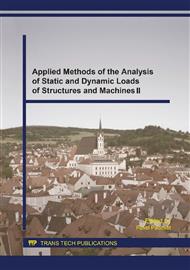p.255
p.259
p.263
p.267
p.271
p.275
p.279
p.283
p.287
The Experimental Determination of One-Axial Tensile Strength of the Textile Reinforced Concrete
Abstract:
This article deals with experimental testing of the textile reinforced concrete samples. The main topic of this article is determination ultimate tensile strength of the textile reinforced concrete. The testing samples were in form “dogbone” for good fixing in testing machine. There are 12 samples totally in experimental program. One type cement matrix and three types (difference in their weight 125 g/m2, 275 g/m2 and 500 g/m2) glass textile reinforcement were used for the production of samples. The textile reinforcement is made of alkali-resistant glass fibres. Three samples were made of cement matrix and nine samples were made of cement matrix reinforced textile reinforcement (three of each type of reinforcement). The samples were tested in special attachment in one-axial tensile. Experimental tests were controlled by speed of rate of deformation (0.0005 m/min). The textile reinforcement has very good influence to behaviour of the textile reinforced concrete in tensile stress.
Info:
Periodical:
Pages:
271-274
Citation:
Online since:
February 2016
Authors:
Price:
Сopyright:
© 2016 Trans Tech Publications Ltd. All Rights Reserved
Share:
Citation:


